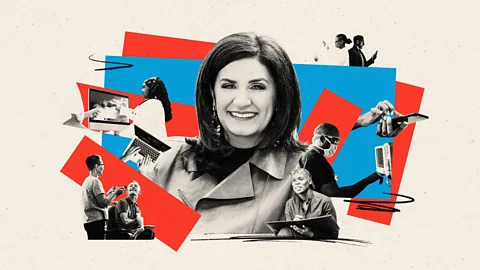How Cisco is bridging the global 'digital divide' to connect the world
 Klawe Rzeczy
Klawe RzeczyFrancine Katsoudas, EVP and chief people, policy and purpose officer at Cisco, enters the BBC's Executive Lounge to talk about how technology can foster equality, safety and innovation.
Every day at Cisco, Francine Katsoudas is laser focused on one mission: bridging the gap between people who can access and use digital technology effectively and those who can't. She calls it the "digital divide" – and says it's never been so important.
"Digitisation can change people's lives," Katsoudas, Cisco's EVP and chief people, policy and purpose officer, tells the BBC. "Our mission statement and end goal is to power an inclusive future for all."
In 2023, the California-based multinational digital-networking and cybersecurity company surpassed its goal of positively impacting one billion lives through its social grants and Networking Academy programmes. Yet Katsoudas feels there's more work to be done.
She's leading Cisco's Country Digital Acceleration (CDA) programme, which partners with business and government leaders to steer national digital agendas as well as support local communities through tailored ethical, innovative technology solutions. This could mean establishing widespread internet access, or streamlining complex processes to expedite medical diagnoses and treatment.
Katsoudas sees potential for the programme to impact more countries and fields, especially as governments increasingly acknowledge the need to grow tech around education, critical infrastructure, sustainability and more. "These projects often start with countries recognising that digital capabilities will, in many cases, make life better for them and their citizens," she says.
She shares her evolving concept of digital inclusion with the BBC, outlines her roadmap for leaders and offers her perspective on the opportunities and challenges in 2024.
Executive Lounge
The BBC's series features interviews with executive leaders making innovative, data-driven decisions helping shape the future of business – and paving the path for other leaders to thrive. Read more conversations here.
How do you define "digital inclusion"?
The definition of digital inclusion evolves as technology advances. But essentially, it's about ensuring everyone has the same ability to digitally access and use essential everyday amenities, such as education and healthcare services.
As technology moves forward, this definition will broaden but, in any service, the most important question to ask is, "does everyone have the same ability to participate?". Ultimately, when true digital inclusion exists, there are very few, if any, situations in which only a small proportion of the general population has access to services that make their lives easier, give them better quality care and so on.
There are many countries around the world – including the US – where 90% of people can digitally participate in all areas of modern life. On the African continent, this number is closer to 40%.
One challenge involved in achieving digital inclusion is the economics of getting on the internet. For instance, we do a lot of work with governments to help them figure out new financial models to make internet access easier.
What framework do you use to determine which areas the digital inclusion program will focus on?
We began our digital inclusion journey proactively, by looking at areas where we thought technology would have the biggest impact. Over the years, our approach has become more reactive. Countries and governments started coming to us with a 'problem statement', describing the issues they wanted to be addressed or the conditions they wanted to be improved.
An example of this is when a hospital in Norway presented us with a problem statement focused on the seven-week time lag from the point of a cancer diagnosis to the cancer patient starting treatment. For those people who have been through something as trying as a cancer diagnosis, this seven-week period is not only scary, but critical. Therefore, we created a CDA program where we brought the data together and connected all the parties, resulting in a reduction of the cancer treatment time from seven weeks to seven days.
 Courtesy of Cisco
Courtesy of CiscoWhat has been your biggest win in digital inclusion?
Given that people are at the heart of everything we do, the biggest successes we've had are when we focus on people and their skills.
For example, in South Africa, we've taken our Networking Academy training – the knowledge we've accumulated from a digital skills and cybersecurity perspective – to create a laboratory on the premises of a government office. In this lab, we offer cybersecurity training to government employees, based on our Networking Academy curriculum.
In this era, cybersecurity attacks are growing in number and sophistication, and, through programmes like this, we can help governments upskill their employees to protect against these attacks, protecting people's data and critical infrastructure such as energy grids and communications.
Additionally, based on fiscal 2021 global survey data of Networking Academy students taking Cisco certification-ready courses, such as CyberOps Associate and CCNA, 95% either secured a job or pursued further education opportunities, and 96% said the programme had a positive impact on their life.
If you were to create a digital inclusion roadmap for leaders, what checkpoints would be included?
Firstly, determine which area your business should focus on, and ascertain how your core business strengths can drive digital inclusion in that area.
Secondly, set a meaningful digital goal based on the impact you want your business to have. For example, with our Networking Academy, we set a goal for the number of students we wanted to educate.
Thirdly, create a no-obligation prototype or pilot to establish whether your goal is possible. In the case of our CDA, for instance, no commitment is needed from a country or government at the pilot stage. We simply outline a potential solution, which the country or government then advises if it meets their needs. If so, we then proceed to scale the solution very quickly.
Lastly, there are lots of great projects in the area of digital inclusion the world over, which we can all learn from. Take the time to understand what has worked and what hasn't, then apply these learnings to your digital inclusion project.
Cisco by the numbers
In terms of your specialty – people, policy and purpose – what opportunities and challenges do you see on the horizon in 2024?
Some of our biggest challenges this year will be the same challenges we've already faced – namely, how we focus on doing everything we can to maximise digital inclusion from a sustainability perspective, and how we can work with our customers and partners around the world to do the same.
Generative AI will be one of our focal points. Using AI, we can help people with their development plans, coaching and careers in ways that we couldn't possibly have done before. There is also the intersection of sustainability and AI, which will be another huge area of focus – and probably challenge – moving forward.
Ultimately, we recognise that a company's work around purpose is most impactful when tied to its core business, rather than when it's treated as a separate and distinct project. Therefore, the biggest goal and the biggest opportunity for us this year will be to ensure that purpose is embedded in every element of our business.
We define "purpose" as how we positively impact communities, both within Cisco and around the world. We’ve articulated this purpose – to power an inclusive future for all – and we leverage our technology, our unique strengths, our people and our broader ecosystems to do so. Our purpose is the contribution we strive to make to society as we do good for business and good for the world.
